Guide to the 20 best Christmas markets in Europe
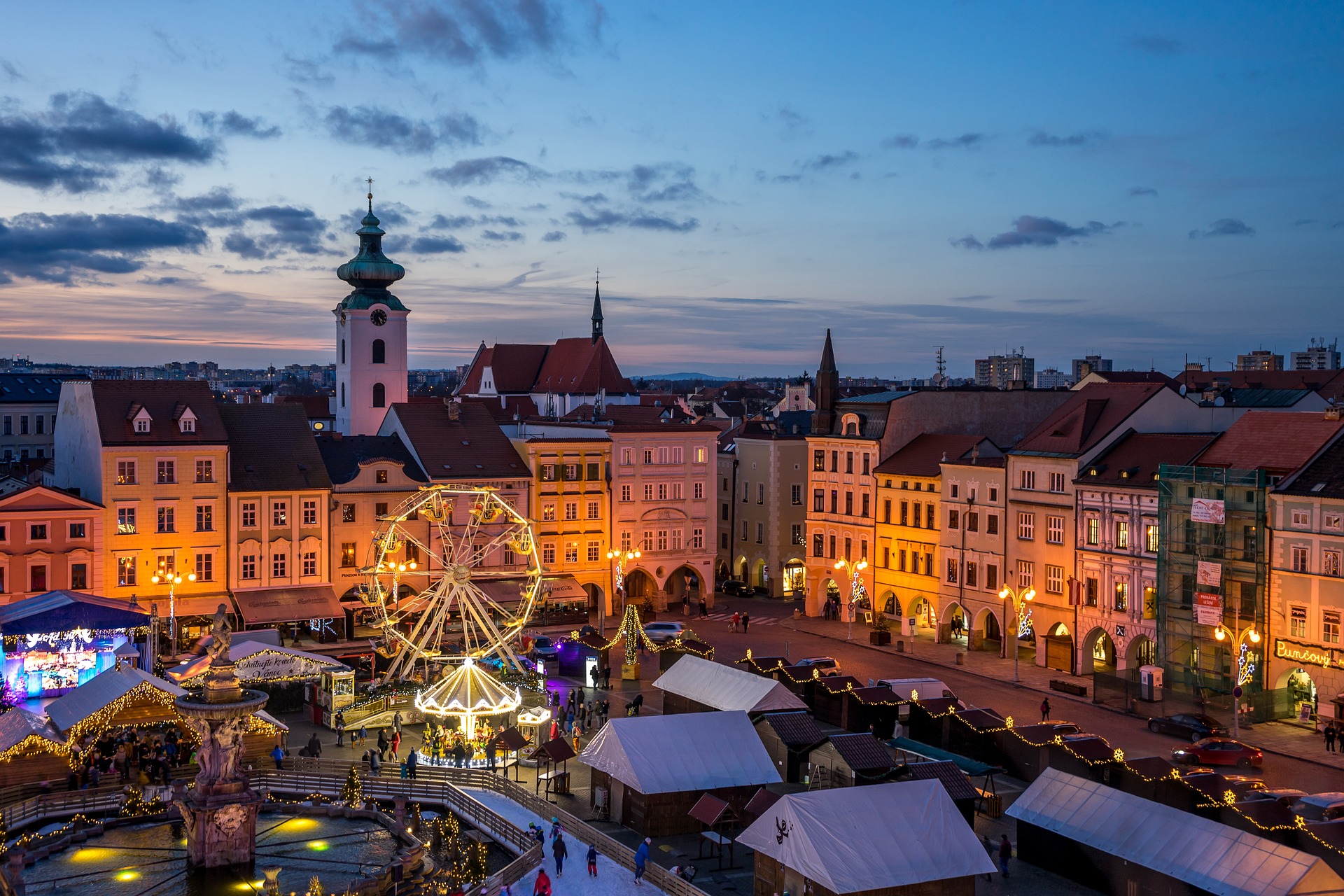
Time to celebrate the holiday season with a list of the 20 best Christmas markets in Europe, including a guide on what to find in each market, where to eat and where to sleep. Come with us and discover the wonders of some of the most ancient advent traditions in the continent.
A strong tradition throughout Central Europe, Christmas markets are a staple of the season, usually starting by late November and lasting all the way to the end of the year, or even to the first few days of January.
Popular among locals and tourists alike, these markets are filled to the brim with original souvenirs, cozy warm drinks and local food specialties. Each city tries its best to decorate their streets accordingly and awaken the season spirit, making for a glitzy and hear-warming atmosphere all across the continent.
As such, we will be showing you 20 of the best Christmas markets in Europe, as well as the best options on where to eat and sleep. Besides the amazing markets, take this opportunity to get to know their cities as well. After all, and although most of these destinations are very much worth your attention all year round, they do get an extra dose of appeal come Christmas season!
The 20 best Christmas markets in Europe

Basel Christmas Market, Switzerland
The Old Town of Basel, more commonly known as its direct German translation of Altstadt, is one of the best preserved in Europe.
That being said, it serves as the perfect setting for two of the best Christmas markets in Europe, located at Munsterplatz and at Barfusserplatz. Right next to the cathedral, the Munsterplatz market is home to the Christmas pyramid, a kind of multi-layered Nativity Scene that usually surprises visitors with its mechanical figures.
As expected – this is Switzerland after all – cheese is king when it comes to the street food. Whether it’s featuring as the gooey filling of a baguette, as a pie/quiche or in a decadent raclette along with potatoes and pickles, there is simply no escaping the grasp of the amazing Swiss cheese.
Dates: November 23 to December 23
Where to stay in Basel:
- Hostel: Hyve Hostel Basel
- £: ibis Basel Banhof
- ££: Novotel Basel City
- £££: Movenpick Hotel Basel
Where to eat in Basel:
- Fischerstube – Traditional
- Brotli-Bar – Traditional
- The Kitchen Focacceria – Pizzas / Focaccias
- Sapori Del Sud – Sandwiches / Snacks
- Manora – Buffet / Café
- il giardino urbano – Pizza / Snacks
- Happy Wok – Asian
- Acento Argentino – Argentinian
- Bäckerei KULT – Bakery / Pastries
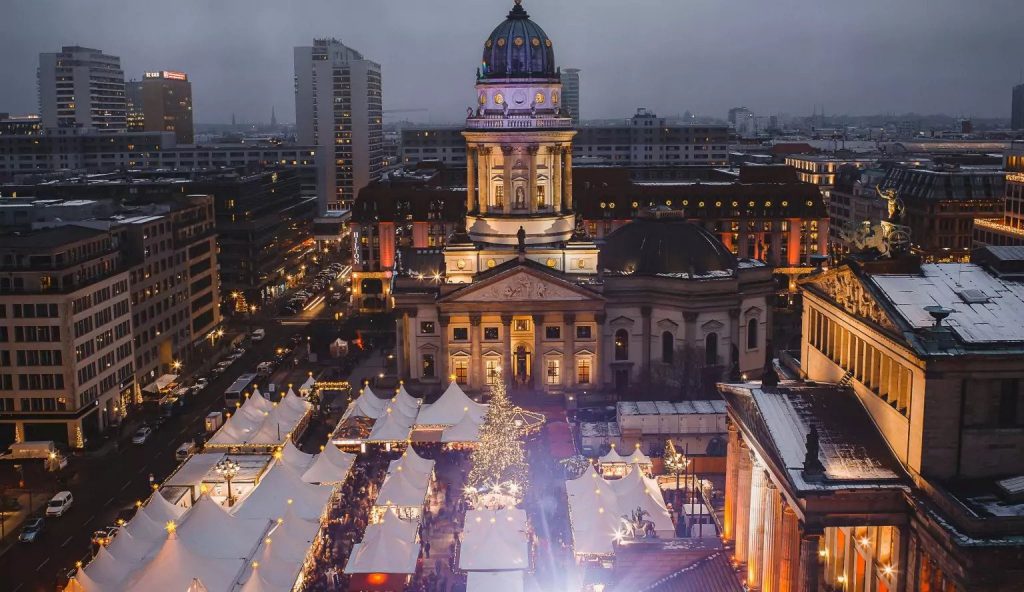
Berlin Christmas Market, Germany
As a nation capital and an absolutely gigantic city, Berlin may not have that tiny and cozy quality to it some of the destinations on this list actually possess, where their markets are set in the local town square around the main church. However, what makes Berlin a unique destination around this time of the year is the diverse plethora of experiences available to visitors.
There are literally dozens of Christmas markets scattered around the city during the advent season, which means choosing is really the only difficult part here. The most popular take place at Gendarmenmarkt, Alexanderplatz and next to the city hall, the Rotes Rathaus.
For a different kind of experience, you may also visit the Spandau market. Set inside the ancient citadel of the same name, it is a delightful crossover between a Christmas market and a Renaissance fair. Another good option usually off-the-beaten-track for most visitors is the Kulturbrauerei market, which is mainly dedicated to the Scandinavian culture and offers some pretty interesting options for foodies.
Dates: November 23 to December 30 (Gendarmenmarkt)
Recommended: 10 best free things to do in Berlin
Where to stay in Berlin:
- Hostel: The Circus Hostel
- £: easyHotel Berlin
- ££: NH Berlin Alexanderplatz
- £££: Radisson Blu Hotel Berlin
Where to eat in Berlin:
- Burgermeister – Hamburger
- The Bird – Hamburger
- Fleischer Domke – Traditional
- Curry 36 – Sausages / Bratwurst
- Alt Berliner Wirtshaus Henne – Traditional
- Restaurant Trattoria Portofino – Italian
- Umami – Asian
- Miss Saigon – Vietnamese
- Hamy Cafe – Vietnamese
- Flamingo Fresh Food Bar – Varied
- Azzam Restaurant – Middle-Eastern
- Mustafa’s Gemüse Kebap – Kebab
- Sammys Berliner Donuts – Donuts
- Zeit Fur Brot – Bakery / Pastries

Brussels Christmas Market, Belgium
Known for the important European institutions it houses, we definitely understand why Brussels may not seem like the most Christmassy of cities. However, and every time we get to late November again, Brussels’s suits and ties are replaced with Santa hats and fake beards, marking the arrival of the holiday season and the start of one of the best Christmas markets in Europe.
Set right in the very heart of Brussels, with its epicenter in the ever-popular Grand-Place (one of the most beautiful squares in the world), the Winter Wonders Festival is the city’s official Christmas Market! With over 250 stalls spread across an area 3km long, this annual event is famous for its themed light shows which fill up the entire city center as well as Brussel’s most prominent commercial districts.
Regarding the typical sweets you’ll be able to find at Winter Wonders, this might be the perfect place to put the famous Belgian chocolate to the test. Whether it comes in a tablet, in a drink or drizzled all over a freshly baked waffle, there is no resisting this temptation!
Dates: November 24 to December 31
Where to stay in Brussels:
- Hostel: Sleep Well Youth Hostel
- £: Bedford Hotel & Congress Centre
- ££: Marivaux Hotel
- £££: Radisson Collection Grand Place
Where to eat in Brussels:
- Ballekes – Traditional Belgian
- Fin de Siècle – Traditional Belgian
- Friture René – Traditional Belgian
- Maison Dandoy – Waffles
- Noordzee – Mer du Nord – Phish
- Maison Antoine – Fries (Belgian specialty)
- Mamma Roma – Pizza by the slice
- L’Express – Lebanese
- Bia Mara – Fish & Chips
- Peck 47 – Brunch / Sandwiches

Budapest Christmas Market, Hungary
Once in the Hungarian capital, visitors will be able to find the city’s main Christmas market at Vörösmarty square. Dead in the middle of the square there are dozens of street food stalls, with other impromptu shops selling souvenirs and other crafts set around the center.
Local specialties may be quite heavy on the stomach, but that also means they are simply perfect to warm up and nourish visitors willing to defy the harsh Hungarian winter. When it comes to food, one couldn’t obviously miss goulash, the savory beef stock standing as the country’s staple dish, which can be sampled at the market inside a hollow bread serving as a bowl.
As for the drinks, we recommend giving it a go at some of the mulled wine and not leaving without trying the local punch called krampampuli. Finally, cap off your meal with some delicious honey bread cakes, a typical cookie (of sorts) which is baked in special molds to create Christmas-themed figures. Good on the eye and good on the taste buds!
Dates: November 18 to January 1
Recommended: Budapest 3-Day Travel Guide: itinerary, hotels, restaurants and tourist attractions
Where to stay in Budapest:
- Hostel: Maverick Hostel & Ensuites
- £: easyHotel Budapest Oktogon
- ££: Boutique Hotel Budapest
- £££: Hilton Budapest
Where to eat in Budapest:
- Belvárosi Disznótoros – Traditional
- Kivansag Ekedze – Traditional
- Öcsi Étkezde – Traditional
- Pest-Buda Bistro – Traditional
- Bors Gastro Bar – Traditional Street Food
- Frici Papa – Traditional
- Hummus Bar – Middle Eastern
- Molnár’s kürtőskalács – Chimney Cake
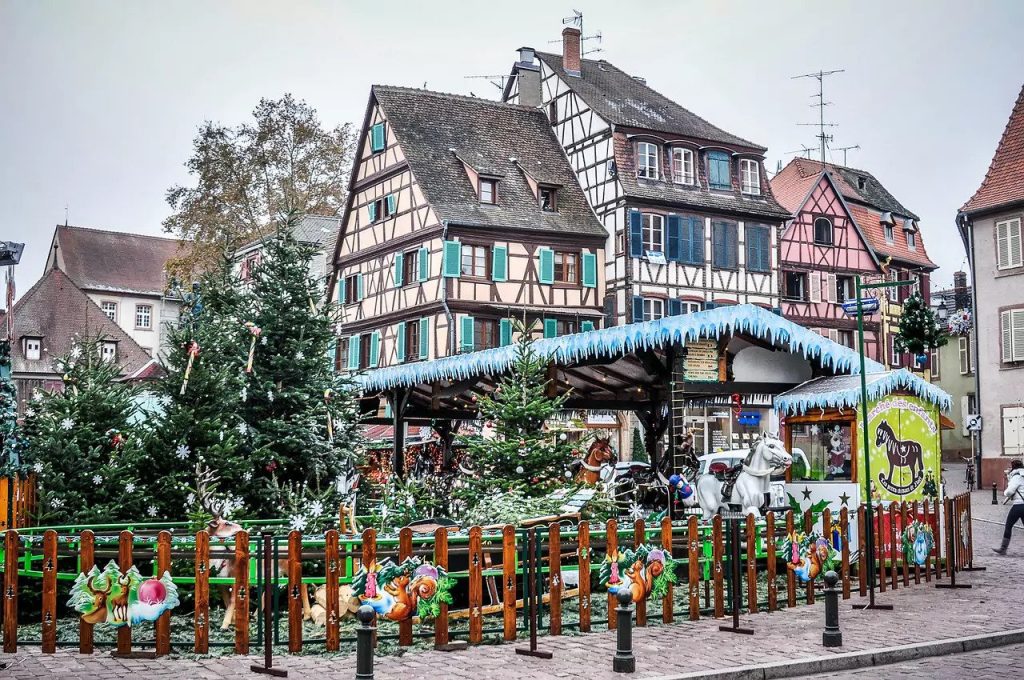
Colmar Christmas Market, France
Kicking-off the French participation on our list of the best Christmas markets in Europe, Colmar is known for its colorful timbered houses. When strolling through its historical quarters, you’ll notice the Lauch River flowing through the picturesque streets and forming a beautiful system of canals which attracts tons of visitors all year round.
However, come holiday season, Colmar turns into a living Christmas fair, with 6 different markets springing up all over town, each with its own special theme.
While visiting these markets, you’ll be able to try the traditional French crepes and wash it all down with some mulled wine. However, and unlike most other cities where mulled wine is usually red, Colmar brews its very own – and much less common – white variety. Why not give it a try?
Dates: November 24 to December 30
Where to stay in Colmar:
- Hostel: There are no good options. We recommend ibis Colmar Centre (€) instead
- £: ibis Colmar Centre
- ££: Grand Hotel Bristol
- £££: Mercure Colmar Centre
Where to eat in Colmar:
- Bistrot Gourmand – Traditional
- La Stub – Flammkuchen
- Version Originale 68 – Traditional
- La Terrasse du Marché – Traditional
- Wistub Brenner – Traditional
- L’Epicurien – Traditional
- Restaurant La Soi – Traditional
- Le Boudoir – Sandwiches / Snacks / Café
- Croq’Vite – Street Food
- UFA of Burger – Hamburgers
- Da Maurizio – Pizza
- Ile aux Saveurs – Varied
- Palmyre – Middle Eastern
- Parisserie Glig – Bakery / Pastries

Cologne Christmas Market, Germany
Although there are multiple Christmas markets spread all over the German city of Cologne, the biggest and most popular is usually set up around the Cathedral, an absolute juggernaut (in a positive way) of a building and the 5th tallest church in the entire planet. Plus, the Cathedral also stands as the city’s most prominent symbol, having resisted the mass destruction Cologne endured during WWII.
As for the market, its area is completely covered in a blanket of lights, earning it some extra points for coziness. While strolling through its many street stalls, you will find all the usual suspects you’d expect to see at a German Christmas market, with decoration pieces, arts & crafts and – of course – delicious food!
An undisputable truth across Germanic lands, food never takes the backseat when it comes to local markets. Therefore, we recommend that you try some of their staple street food options, such as pretzels, potato pancakes (reibekuchen) or the famous German sausages (bratwurst). Cap it off with a nice cup of mulled wine and you’re ready for bed!
Dates: November 23 to December 23
Where to stay in Cologne:
- Hostel: Hotel im Kupferkessel
- £: Hotel Domstern
- ££: Azimut Hotel Cologne
- £££: Cologne Marriott
Where to eat in Cologne:
- 1980 Cafe & Banh Mi – Vietnamese
- Toscanini – Italian
- Bay Area Burrito Company – Mexican
- Brauhaus Pütz – Traditional German
- Beef Brothers – Hamburgers
- Bai Lu Noodles – Chinese
- Rievkoochebud Reibekuchen – Traditional potato pancakes
- Thai Imbiss Eigelstein – Thai
- Yummy Town – Chinese Buffet
- Kebapland – Kebab
- Habibi – Lebanese
- Gaststätte Lommerzheim – Traditional German

Copenhagen Christmas Market, Denmark
Considered one of the biggest tourist attractions in Copenhagen, the Tivoli Gardens are a huge and picturesque amusement park, operating since 1843. However, and despite high demand, there are only two seasons outside of spring and summer months when the park is open to visitors: Halloween and Christmas! And it’s totally worth the wait, because the Tivoli Gardens put up what is certainly one of the best Christmas markets in Europe!
Therefore, if you’re one of the lucky bastards traveling to Copenhagen for the holiday season, a visit to the park – despite its rather pricey tickets (145 DKK = around 20€) – is in order! After all, entering Tivoli is almost like being welcomed into an alternative reality, with the grounds suffering a complete overhaul for Christmas.
Besides all the decoration and atmosphere, the Tivoli Gardens are obviously popular for some of their insane rides, such as the rollercoaster “The Demon” or the award-winning “The Vertigo”. Just keep in mind the admission ticket does not include any rides, so for that you’re going to have to either buy your entrance to each ride separately or get a special Ride Pass (245 DKK = around 33€) for your visit.
Dates: November 17 to December 31
Where to stay in Copenhagen:
- Hostel: Next House Copenhagen
- £: Cabinn Copenhagen
- ££: Copenhagen Strand
- £££: Nh Collection Copenhagen
Where to eat in Copenhagen:
- Skt. Peders Bageri – Bakery
- Laboca – Empanadas
- Dalle Valle – Buffet “all-you-can-eat”
- Riz Raz – Vegetarian Buffet (à la carte includes meat dishes)
- Gasoline Grill – Hamburgers
- Ugood – Rolex Sandwich (Uganda)
- La Tre Street – Vietnamese
- GAO – Dumplings
- La Neta – Mexican
- Folkehuset Absalon – Casual / Community Restaurant
- DØP – Hot Dogs
- Pizzeria La Fiorita – Italian
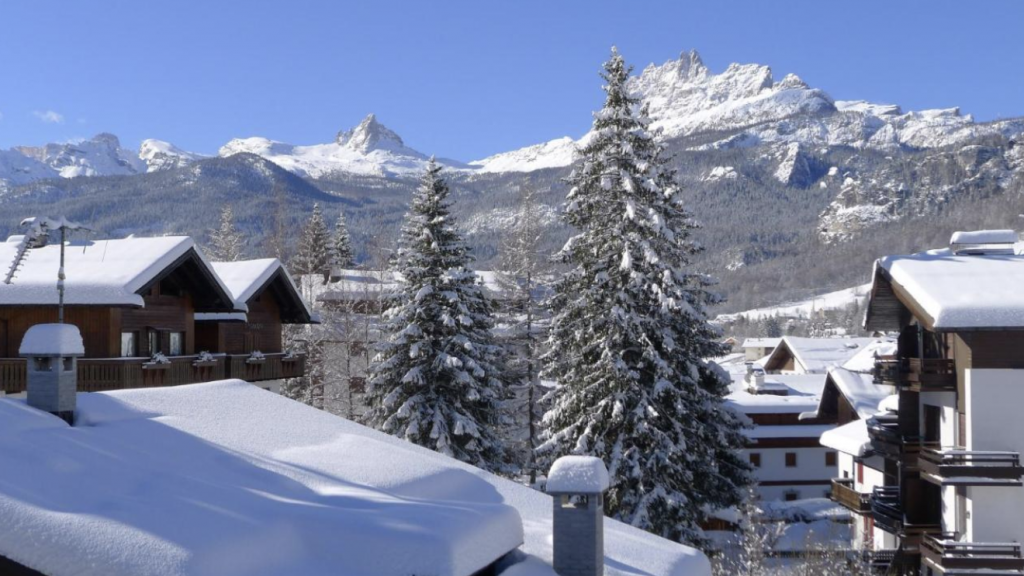
Photo credit: Hotel Bellaria
Cortina d’Ampezzo Christmas Market, Italy
Located in the mountainous Italian region of the Dolomites, the small town of Cortina d’Ampezzo may no longer be a part of Austria, but their 400-year-old control over the area certainly left a mark. After all, if there’s something Germanic nations are good at, is organizing the best Christmas markets in Europe!
Set up along the charming central street of Corso Italia, the Cortina d’Ampezzo Christmas Market is one of the many season events established all over the Dolomites. Small and quaint, it is the perfect place for a relaxing stroll after a busy day at the ski slopes in the company of a cup of mulled wine and a handful of roasted chestnuts, one of the village’s surprising specialties.
If possible, try to time your visit with the Feast of Saint Nicholas, a local Christmas fest and pilgrimage. Taking place on the 5th and 6th of December every year, the entire village goes out on the streets to see the special parade. Ending at Rifugio Averau, it will reward the most resilient walkers with one of the best panoramic views over the entire range of the Dolomites.
Dates: December to January (no specific dates set yet)
Where to stay in Cortina d’Ampezzo:
- Hostel: No hostels available. We recommend staying at Hotel Bellaria (£)
- £: Hotel Bellaria
- ££: Hotel De La Poste
- £££: Hotel Cristallino d’Ampezzo
Where to eat in Cortina d’Ampezzo:
- Pizzeria Ai Due Forni – Pizza by the slice
- Ampezzo Pizza – Pizza by the slice (seated)
- Hacker Pschorr Haus – Beerhouse / Tyrolese
- Panino Top Bar – Sandwiches and Paninis
- Molo Pub – Sandwiches and Hamburgers
- Pontejel Bierstube Forst – Traditional Tyrolese
- Bob Bar – Sandwiches and Toasts

Krakow Christmas Market, Poland
Although the Polish Christmas markets may not be as popular as those of their German counterparts, that doesn’t mean you won’t be able find some of the best Christmas markets in Europe while exploring Poland! In fact, in a country famous for its fierce Catholicism, not celebrating Christmas accordingly would be completely out-of-character.
So, let’s talk about Krakow, Poland’s tourism postcard picture. Considered the former imperial capital of the country, the city is also home to the largest medieval square in the world (Rynek Glowny), which is precisely the place where the local annual Christmas market takes place. Besides, being a substantially cheaper country than its westernmost neighbors, it is a great place to allow yourself to splurge a bit – and rightfully so, because Poles certainly don’t mess around when it’s time to eat!
That being said, and although you definitely won’t be strapped for choice, there are two or three little things we must recommend trying! Besides Oscypek (a smoked cheese grilled in front of your eyes and served with cranberry jam) and pieriogis – Poland’s national dish – do NOT leave the market without sinking your teeth into a Zapiekanka. A sort of “pizza-on-steroids” served in an open-faced baguette, it is the perfect snack to soak in all of the alcohol from the fruit-flavored vodkas you’ll be offered.
Dates: November 24 to December 26
Where to stay in Krakow:
- Hostel: Bubble Hostel
- £: Hotel Secesja
- ££: Hotel Maksymilian
- £££: Radisson Blu Hotel
Where to eat in Krakow:
- Restauracja U Babci Maliny – Polish
- Bar pod Okrąglakiem – Zapiekanki (traditional street food)
- Chimera – Polish milk bar (soviet canteen style)
- Smaki Gruzji – Georgian
- Dolabella Due – Italian
- Mirror Bistro – Pierogis (Polish dumplings)
- Szynk – Polish
- GOGO Burger – Hamburgers
- Milkbar Tomasza – Polish milk bar (soviet canteen style)
- Vegab – Vegan fast-food
- Ku Ku Taiwanese Food & Bubble tea – Taiwanese
- Mazaya Falafel – Lebanese
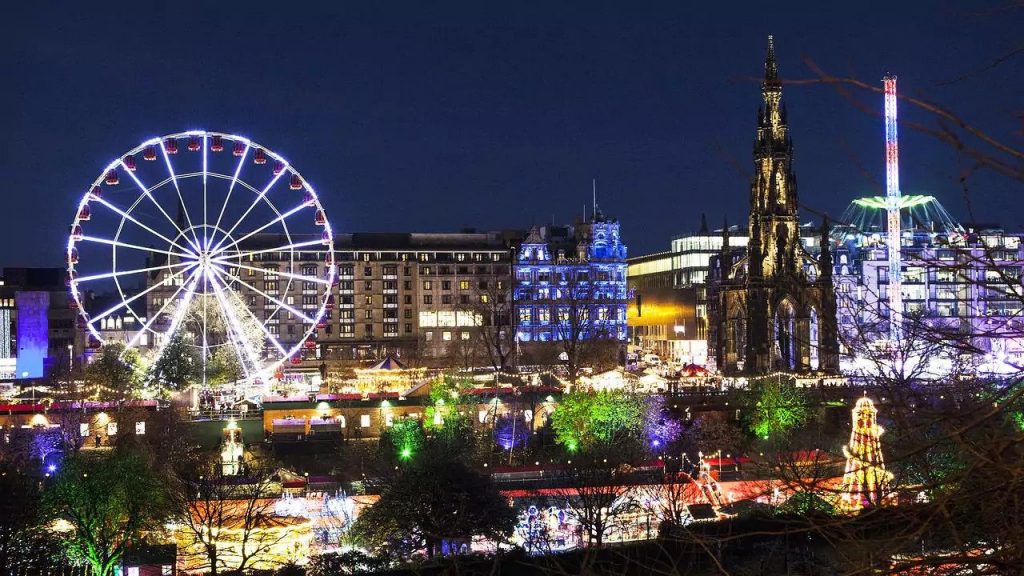
Edinburgh Christmas Market, the UK
Edinburgh’s historical city center, known as the Royal Mile, is the city’s most famous tourist hotspot. Besides its architectural wonders, this is also a bustling, lively area, popular for its huge street fests during the summer (such as Fringe) and one of the best Christmas markets in Europe during winter.
The city’s main market takes place at the Princes Street Gardens, the meeting point between the Old and the New towns, with the imposing Edinburgh Castle – the Scottish capital’s main landmark – peeking over the hill. Here you’ll be able to find a very diverse variety of typical Scottish souvenirs, such as tartan scarves made of wool and cashmere.
Should the cold start getting to you, it may be a good idea to warm yourself up with authentic Scottish whisky or, for something a bit more on the sweeter side, some hot chocolate mixed up with Bailey’s. In fact, a bit of alcohol might actually be the trigger you need to give it a go at the ice rink… at the very least you won’t be feeling so bad about the falls!
Dates: November 17 to January 06
Where to stay in Edinburgh:
- Hostel: High Street Hostel
- £: Cityroomz Edinburgh
- ££: Yotel Edinburgh
- £££: Intercontinental Edinburgh
Where to eat in Edinburgh:
- The Halfway House – Traditional / Pub
- Wetherspoon – Pub
- Howie’s Restaurant – Traditional
- Snax Cafe – Café / Brunch
- The Mosque Kitchen – Indian
- Mother India – Indian
- Oink – Pulled Pork Sandwiches
- The Tron – Hamburger
- Saboteur – Asian
- Piemaker – Traditional Pies
- Kebab Mahal – Kebab
- Chez Jules – French
- El Cartel – Mexican
- Pizza Posto – Pizza

Strasbourg Christmas Market, France
Known for hosting one of the best Christmas markets in Europe, and located in the easternmost French region of Alsace, the city of Strasbourg starts popping up on a lot of people’s bucket list once temperatures start going down.
Its Notre-Dame Cathedral, which took over 400 years to be built and reigned supreme as the tallest building in the world for another 200, stands as the main landmark of this medieval city set on the riverbanks of the Rhein. With its timbered houses and colorful façades, Strasbourg calls itself the “Capital of Christmas” … and rightfully so! There are over 300 stalls scattered across several different markets, with Christkindelsmarik as the biggest in the city.
As for the food, the local specialties sold at the markets help reflect Strasbourg’s diverse background, with a double identity split evenly between France and Germany. Therefore, this is a place where you can both have baguette flambée and pretzels – the best of both worlds! At the end of the day, and whether you call it vin chaud or glühwein, the most important thing is to toast the season with a nice cup of mulled wine.
Dates: November 24 to December 24
Where to stay in Strasbourg:
- Hostel: The People – Strasbourg
- £: ibis Strasbourg Centre Historique
- ££: Aparthotel Adagio Strasbourg
- £££: Sofitel Strasbourg Grande Ille
Where to eat in Strasbourg:
- Chez Victor Tribunal – Traditional
- La Cloche à Fromage – Traditional
- Le Thomasien – Traditional
- Pizz’arome – Italian / Pizza
- Fior di Pizza – Italian / Pizza
- Habibi Strasbourg – Middle Eastern
- Bo & Bun Viet Food – Vietnamese
- L’Epicerie – Sandwiches / Snacks / Café
- Lamian Restaurant – Chinese Noodles
- L’Atelier 116 – Bakery / Pastries
- The Devil’s Mill Crêperie – Crepes

London Christmas Market, the UK
We move forward with what is probably the most famous Christmas event in Europe – London’s iconic Winter Wonderland. Admission rules to the fair’s grounds, located in Hyde Park, will depend on the timing of your visit. Needless to say, the times with the most demand require a ticket to enter, whereas admission on weekday mornings before December 8 are actually free (until 2pm). For the remaining days/timeslots, tickets start from 5£, up to 7,50£.
After guaranteeing your ticket, and once inside the grounds, you will find everything you can possibly fathom about Christmas and the winter season. Ice rinks, giant wheels, fair rides, ice bars, special workshops, music and circus performances, themed trains and even VR experiences – you name it! However, keep in mind none of these experiences is included in the admission ticket.
Deep down, this is one huge Christmassy amusement park! However, and because London will forever be one of the most sought-after destinations in the world, the event keeps on attracting large crowds from all over the globe. Therefore, and because its commercial appeal also plays a huge part, it’s impossible not to look at Winter Wonderland as one of the best Christmas markets in Europe.
Dates: November 17 to January 01
Where to stay in London:
- Hostel: Publove @ The White Ferry, Victoria
- £: The Z Hotel Holborn
- ££: The Z Hotel Piccadilly
- £££: Montcalm East
Where to eat in London:
- Isabel Mayfair – Traditional
- Scott’s – Traditional
- Pubs do Grupo Wetherspoons – Pub / traditional
- Mark’s Club – Traditional
- Chucs – Traditional
- Punjab – Indian
- Alladin Kebabish – Pakistani
- Da Maria– Italian
- Bancone – Italian
- Dumplings’ Legend – Chinese
- Kokeb – Ethiopian
- Ma Petite Jamaica – Caribbean
- Yalla Yalla – Lebanese
- Kintan – Japanese
- Addie’s Thai – Thai
- Banh Banh – Vietnamese
- Phat Phuc Noodle Bar – Noodles/Vietnamese
- BiBimBap – Korea
- Homeslice – Pizza by the slice
- Pizza Union – Pizza by the slice
- Poppie’s – Fish & chips
- The Windmill Pub Mayfair – Pub / traditional
- Regency Cafe -English Breakfast

Luxembourg Christmas Market, Luxembourg
Set up at Place d’Armes, one of the main squares in the heart of the Luxembourgish capital, the local Christmas market is part of the Winterlights Festival, an annual celebration where street stalls, music concerts, cultural exhibitions and workshops erupt all over the city.
At the center of it all you will find Chrëschtbeemchen, a 12-meter-tall Christmas tree around which most visitors gather to watch the special lightshows that take place 4 times a day. Although these exhibits are quite brief, they do provide a true explosion of color, capable of cheering up even the grinchiest of spirits!
When it comes to food, and considering Luxembourg is such a small country where its neighbors’ influence runs strong, we recommend trying a typically Luxembourgish dish. Therefore, if you’re fond of the idea of fighting the cold with some steaming-hot potato dumplings, do not leave one of the best Christmas markets in Europe without sampling kniddelen.
Dates: November 24 to January 01
Recommended: Luxembourg 2-Day Travel Guide – Hotels, Restaurants, Money and What to see in 48 hours
Where to stay in Luxembourg:
- Hostel: Youth Hostel Luxembourg City
- £: Ibis Styles Luxembourg Centre
- ££: Mercure Luxembourg Off Kirchberg
- £££: Sofitel Luxembourg Europe
Where to eat in Luxembourg:
- Independent Café – Hamburgers
- Dancing Noodles – Asian
- Café Santos Ribeiro – Portuguese
- Persian FoodBox – Iranian
- Kumpir – The Happy Potato – Turkish
- Alison Café – Café/Quick meals
- Mr Mai VietNam Food – Vietnamese
- Pasta Buongiorno – Italian
- Nirvana Café – Indian/Vegan
- Thai Snack – Thai
- Krishna Vilas – South Indian

Metz Christmas Market, France
The city of Metz, located in the French district of Lorraine, may not get the same attention from tourists as other local powerhouses, but with its beautiful city center and one of the most imposing cathedrals in Europe, it is very much worth a visit.
However, it is during the holiday season that Metz shines brighter. Despite the city’s small size, this is where you will find one of the best Christmas markets in Europe, as well as one of the most visited in France. The city’s historical core, already a very beautiful area all-year-round, gets even prettier during this season, with its impeccably decorated wooden stalls and festive atmosphere.
The whole picture is completed with a giant wheel, an ice rink and a stunning lightshow projected into the cathedral’s façade.
Dates: November 24 to December 30
Where to stay in Metz:
- Hostel: Hotel du Centre
- £: Campanile Metz Centre Gare
- ££: Mercure Grand Hotel Centre Metz Cathedrale
- £££: Hotel la Citadelle Metz
Where to eat in Metz:
- Le Bistrot de G – Traditional
- Au Cul d’Poule – Traditional
- Oriental Kebab – Middle Eastern
- La Fabrique – Middle Eastern
- MONA Italian Street Food – Italian / Pizza
- La Casa di Jo – Italian / Pizza
- Casa Ricci – Italian
- Fox Cofee Shop – Café
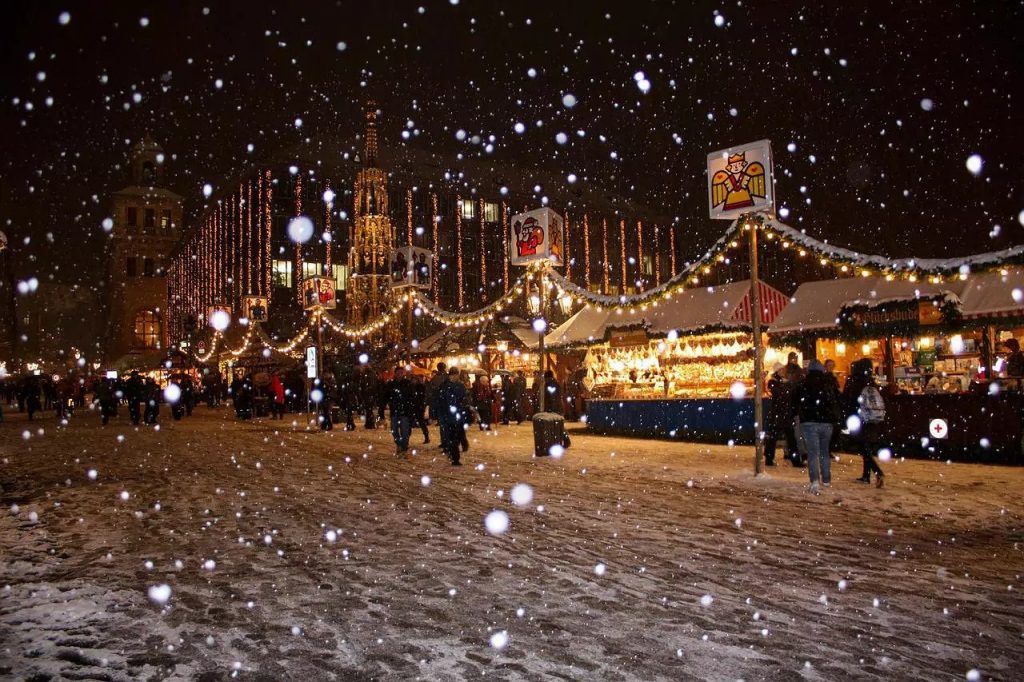
Nuremberg Christmas Market, Germany
During most of the year, Nuremberg is a calm, quaint city. After taking a walk through the Main Market Square (Hauptmarkt), visitors can climb all the way up to the castle for the views and then, on their way down, stop by the House of Albrecht Dürer, the greatest master of German Renaissance and one of the city’s most revered hometown heroes.
Outside of the holiday season, the main square usually takes in several stalls selling fruits, veggies and other produce. However, come late November, that same space is taken over by the Christkindlesmarkt, one of the best Christmas markets in Europe and at the same time the most traditional and authentic in Germany.
Adjacent to this market you will find another, much less orthodox option. Honoring Nuremberg’s official “Sister Cities”, this secondary mini-market displays stalls dedicated to the traditions of places like San Carlos (Nicaragua), Shenzhen (China) or Skopje (North Macedonia).
Dates: December 01 to December 24
Where to stay in Nuremberg:
- Hostel: Five Reasons Hostel
- £: Ibis Nurnberg Hauptbanhof
- ££: Holiday Inn Nurnberg City Center
- £££: Le Meridien Grand Hotel
Where to eat in Nuremberg:
- Café Wanderer – Traditional / Beerhouse
- Bratwursthausle bei St. Sebad – Sausages (Bratwurst)
- Albrecht Dürer Stube – Traditional
- Schäufelewärtschaft – Traditional
- Fränkische Weinstube – Traditional
- Hausbrauerei Altstadhof – Traditional
- Restaurant Burgwächter – Traditional
- Restauration Kopernikus – Schnitzel
- Zum Gulden Stern – Traditional
- Wurstdurst – Snacks
- Hot Tacos – Mexican
- Brezen Kolb – Pretzels
- Mam-Mam Burger – Hamburgers
- Gold Thai Imbiss – Thai
- Red Curry House – Asian

Óbidos Christmas Market, Portugal
Relatively far away from the traditional holiday circuit, it may come as a surprise to many that Portugal actually hosts what can be considered one of the best Christmas markets in Europe!
Located in the small ancient walled town of Óbidos, the local Christmas market (officially promoted as Óbidos Vila Natal) has been growing in popularity over the past few years. However, and unlike most options on this list, admission to the fair’s grounds – set inside the local castle – is actually paid. Be that as it may, the season’s festive atmosphere and swarms of visitors always end up overflowing past the castle’s gates, providing a very different experience for tourists when compared to the rest of the year.
Once inside “Vila Natal”, and looking past the traditional Christmas decorations and street food stalls, you will find a special stage for music performances, an ice rink and the iconic Santa House, where children can have their picture taken with the famous bearded fellow!
Dates: November 30 to December 31
Where to stay in Óbidos:
- Hostel: Hostel Argonauta
- £: Obidos Aquae Ductus Suites
- ££: Josefa D’Obidos Hotel
- £££: Pousada Castelo De Obidos
Where to eat in Óbidos:
- Senhor da Pedra – Portuguese
- Capinha d’Óbidos – Bakery / Tapas
- Infusion – Snacks and Tapas
- Taberna O Lidador – Portuguese
- Pretensioso – Portuguese
- Avocado Coffee & Healthy Food – Brunch, Bowls and Toasts
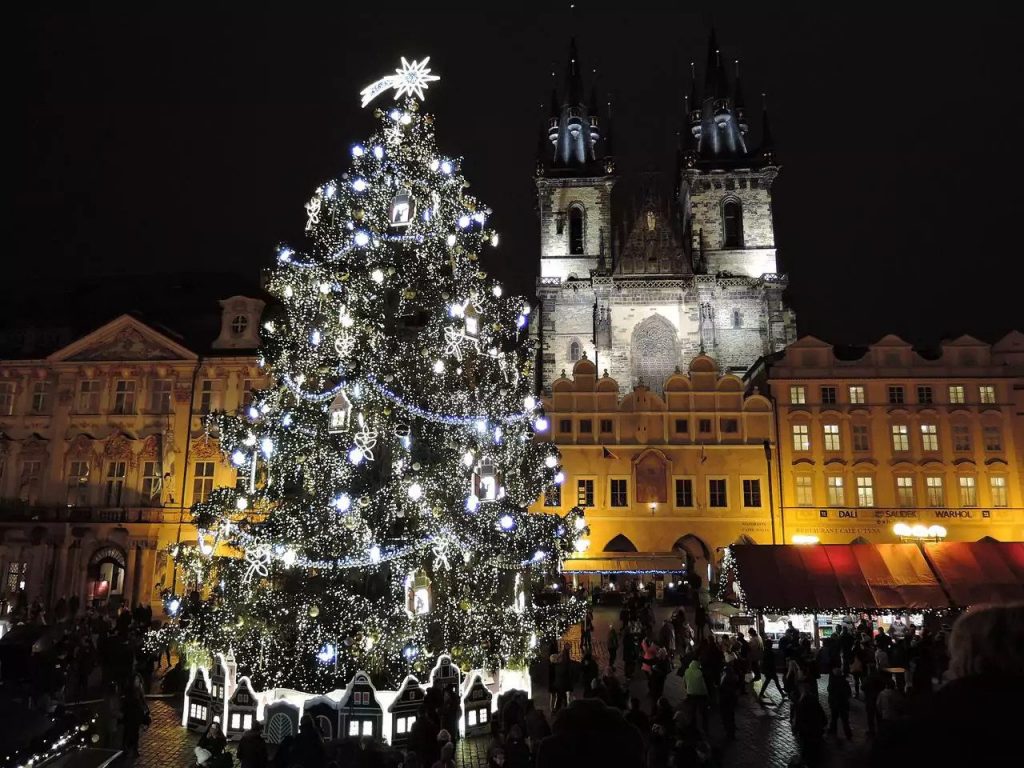
Prague Christmas Market, Czech Rep.
Throughout much of the year, Prague’s Staroměstské, or Old Town Square, is already one of the Czech capital’s most recognizable spots, housing some of the city’s biggest landmarks such as the Cathedral of Our Lady Before Týn or the Astronomical Clock.
But during Christmas season, and thanks to one of the best Christmas markets in Europe, the square gets even more interesting! From the Hungarian goulash to the quintessentially Czech Rybí Polévka, a soup fish cooked with brandy and cream, this is certainly not the place for the weak of stomach! As for the kids, you will certainly find them drooling all over the infectious scent of trdelník (or chimney cakes) filling up the air.
Shying away from the main square, other hotspots such as Václavské or Republiky also set up their own markets, spreading the wonders of the holiday season all over the city.
Dates: December 02 to January 06
Recommended: Prague 3-Day Travel Guide – What to See and Do in the “City of a Hundred Spires”
Where to stay in Prague:
- Hostel: Hostel Little Quarter
- £: Hotel Atos
- ££: Hotel Praga 1
- £££: Dancing House Hotel
Where to eat in Prague:
- U Parlamentu – Traditional
- U Červeného páva– Traditional
- Lokál – Traditional
- Restaurace Mincovna – Traditional
- Krčma – Traditional
- Nase Maso – Meat / Local fare
- Jídelna Světozor – Traditional
- Pho Vietnam Tuan & Lan – Vietnamese
- Ladislav Cerveny – Hot Dogs
- Jizerske Pekarny – Bakery / Pastries
- Cafe Cafe – Bakery / Pastries
- Good Food, Cofee and Bakery – Chimney Cake / Trdelnik

Tallinn Christmas Market, Estonia
As surprising at is may sound to some, Tallinn’s old town is actually one of the most beautiful and best preserved in the world. Even though it is the capital of Estonia, the city itself is relatively small, with most of its tourist attractions – such as the Cathedral of Alexander Nevsky and the Old Town Hall – heavily concentrated within the same central area, perfect to explore on foot.
When it comes to the holiday season, the city claims a very important milestone, having been the place where (according to some sources) the first ever public Christmas tree was displayed, back in 1441. Although the neighboring capital city of Riga (Latvia) disputes these claims, and wherever the truth may lie, it still goes to show how important Christmas celebrations are in Tallinn. And even though the city’s market was only created in 1997, it has already earned its place among the best Christmas markets in Europe!
Aside from the craftsmanship, representative of Estonian folklore and of the traditions of all the different peoples who have called this land home, most visitors are attracted to the amazing street food on display. Case in point: the Verivorst, a local blood sausage which, despite its pretty intense look, is considered a national delicacy!
Dates: December 01 to January 7
Where to stay in Tallinn:
- Hostel: City Hotel Tallinn
- £: Citybox Tallinn
- ££: Rija Fonnental Design Hotel
- £££: Swissotel Tallinn
Where to eat in Tallinn:
- Pegasus – Traditional
- Sesoon – Traditional
- Ill Draakoon– Pub / Traditional
- Karja Kelder – Pub / Traditional
- Kompressor – Pancakes
- F-Hoone – Brunch / Asian
- Restaurant Lido – Buffet
- Jahu Tänavagurmee – Hamburger
- Burger Box – Hamburger
- Kaja Pizza Köök – Pizza
- Bueno Gourmet – Street Food
- Boheem – Café / Brunch
- Bogapott – Café / Brunch
- Kohvik Energia – Café / Brunch
- Reval Café – Café / Brunch
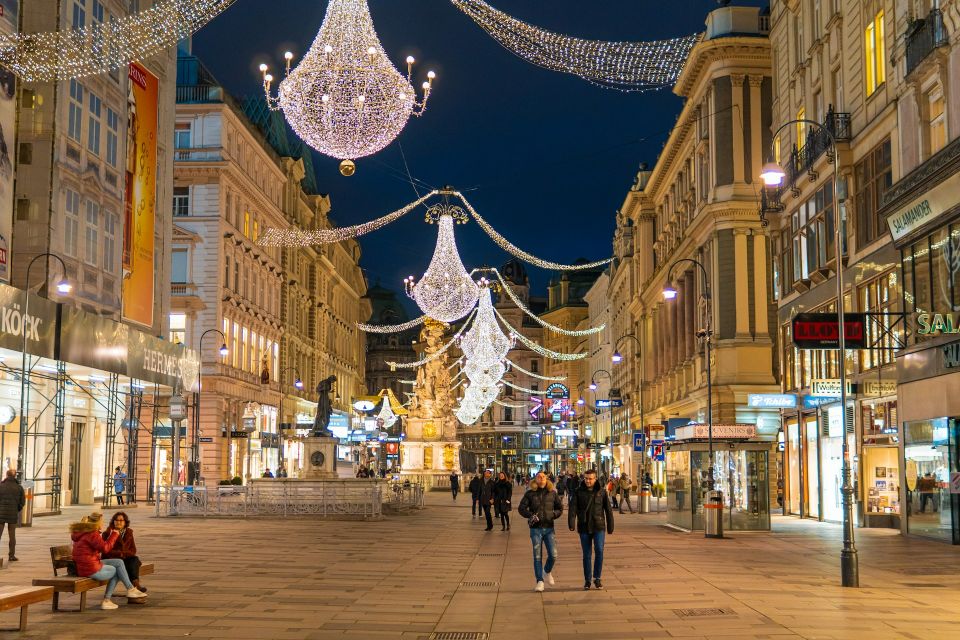
Vienna Christmas Market, Austria
In Vienna, Christmas markets are organized a bit differently from most of the remaining places on our list. Besides not being a single event under the umbrella of the same organization, there is also no centerpiece around which everything unfolds. Instead, there are several separate markets scattered all over the Austrian capital, each with its own focus and character, making visitors feel like celebrations take place everywhere they go and solidifying this as one of the best Christmas markets in Europe!
Among the many options available, we recommend you create your very own customized circuit, visiting the markets at Stephansplaz, Maria-Theresian-Platz and Spittelberg, before finishing your walking tour at Altes AKH, a special Christmas event taking place inside the University campus. Also, if you’ll be palace-hopping during your visit to Vienna, there are also impromptu Christmas markets set within the grounds of the Schonbrunn and the Belvedere palaces.
Saving the best for last, the biggest and most eccentric Christmas market in Vienna takes place right in front of the Rathaus – the majestic building of the City Hall. While walking through the lively Christkindlmarkt, composed of more than 200 stalls, don’t forget to try the famous Strudel, the country’s signature dessert.
Dates: November 11 to December 26
Where to stay in Vienna:
- Hostel: Wombat’s City Hostel Vienna Naschmarkt
- £: Hotel Mozart
- ££: NH Wien Belvedere
- £££: Intercontinental Vienna
Where to eat in Vienna:
- Figlmüller – Schnitzel
- Schnitzelwirt – Schnitzel
- Gasthaus Elsner – Traditional Austrian
- Schachtelwirt – Traditional Austrian
- Würstelstand zum Hohen Markt – Sausages / Bratwurst
- Swing Kitchen – Hamburgers
- Knödel Manufaktur – Knodel (traditional potato dumplings)
- Trzesniewski – Traditional Sandwiches (Brotchen)
- Café Landtmann – Strudel
- Café Sacher Wien – Sachertorte

Zagreb Christmas Market, Croatia
Despite not being the most popular or iconic among common vacation-goers, it is in the Croatian capital that visitors will actually find one of the very best Christmas markets in Europe. And considering the country’s history and how difficult it was for common Croatians to keep their catholic faith, is it really that surprising that they make such a big fuss of Christmas?
Known officially as Advent Zagreb, this sprawling market is actually a concoction of as many as 25 independent markets, all of which contributing towards a huge event occupying pretty much the entire Old Town.
The market is famous for its stalls selling hand-carved toys, an artsy tradition from the north of Croatia recognized by UNESCO as Intangible Cultural Heritage. Moving on to food, Zagreb might not be the ideal place if you belong in that very special category of people who cannot open up a bag of cookies without eating the entire thing. From paprenjaci (pepper and ginger cookies) to licitari (decorative sweet honey dough biscuits) and kiflice (half-moon shaped walnut cakes) maybe it’s just better to get your belly ready for what’s coming.
Dates: December 02 to January 7
Where to stay in Zagreb:
- Hostel: Swanky Mint Hostel
- £: Hotel International
- ££: Hotel Academia
- £££: The Westin Zagreb
Where to stay in Zagreb:
- Heritage – Sandwiches/Croatian
- Curry Bowl – Sri Lankan
- Vagabund – Grilled meats (Cevapi and other traditional cuts)
- Plac – Sandwiches and Hamburgers
- Korica – Bakery and Brunches
- Gajbica – Vegetarian
- Taquitos Bandidos – Mexican
- Umami – Asian
- El Greco – Greek
- Gostionica Ficlek – Croatian / Traditional
Traveling soon? Get your Holafly eSIM with a 5% discount for unlimited internet access in any destination. No more worrying about roaming charges or finding local SIM cards. Enjoy unlimited data and stay connected with ease. Order your Holafly eSIM now »
Heymondo offers a wide range of travel assistance insurance policies. They combine the best quality, service and price with various levels of coverage, so you’re covered on your weekend getaways and long trips. Buy insurance »








